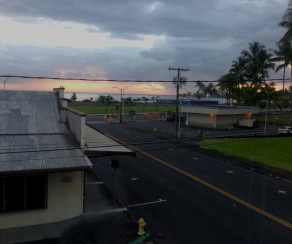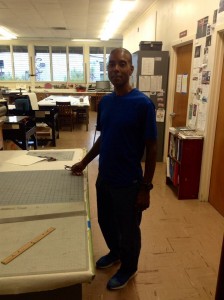I awoke at 4:30 am and noticed the new tenants of the guitar shop loading dock, shot off a few emails and settled into reading a book about the big island. I always research new places I visit. On my first trip to the state of Hawai’i I was keenly aware of having been misled by tall tales of early contact with savage kingdoms and riveting performances by Jack Lord and Don Ho.
My goal was to be open to whatever I might find, and had become aware of protests against the construction of a massive new telescope on the summit of Mauna Kea, the Big Island’s highest peak at 13,796 feet above sea-level, which is regarded as sacred by indigenous Hawaiians. I saw a parallel between the contest over Mauna Kea and some of my earlier subjects like Civil War and Indian War battlefields. Years ago I had participated in a fundraising exhibition to protect the Big Mountain Reservation in Arizona. Throughout the course of our visit I became increasingly aware of how profound were the divisions within the community concerning the proposed Mauna Kea observatory. Almost nobody we met held a neutral position. Most were either for or against the plan with considerable passion, which I took as a warning to stay out of the fray.
As dawn broke, Hilo Bay stretched out like a sheet of beaten silver beneath rosy, clouded skies, a spectacle played out behind the electric glow of the Tesoro gas station at the corner of Ponahawai and Kamehameha. Kathie figured out how to make coffee in the room by inserting single–serve Melitta packets into a Keurig-like contraption. Neil the landlord later confessed that after he bought the machine, he could never find packets to fit it. Frustrated and maniacal about her coffee, Kathie wondered aloud why he hadn’t replaced it. One of these days, Neil replied. One of these days.
We wandered out into the street in search of breakfast. Paul’s café on the ground floor of the Pakalana building was open but had only three tables. Every one of them was full. An empty table stood outside the door on the sidewalk. We were told that there was a wait list and if we wanted to leave a name they would call us.
Seeing no one else waiting, we drifted off through the open-air market at the other end of Punahoa Street, past Reuben’s toward the center of town where we found the Surf Break Café.
The coffee was serviceable. The oatmeal was mixed with nuts and dried fruit and had an odd crunchy texture. I looked at my watch. Six hours.
In New York it would be two o’clock in the afternoon. Suddenly the lackadaisical notion of Hilo Time made sense. Whatever the clock said, the time is always now, at least most of the time.
Kathie returned to the Pakalana Inn while I proceeded to University of Hawai’i at Hilo to meet Mike Marshall and review our plans for the next two weeks.
I found him in building 395 on the community college campus. The art studios had been moved from the main campus, up the hill a mile to the west, while faculty were still expected to keep their office hours at the main campus. It seemed like a bit of a cockamamie arrangement but like at most public universities today, the arts at Hilo are fighting redundancy, and pressure to demonstrate specific vocational values for the undergraduate degrees they offer. Things in favor of the art department at Hilo is that it only offers a Bachelor of Arts degree, and it has a superb printmaking facility making it possible to argue that students coming out of the program have sufficient training to find tech work in fine art publishing, perhaps at places like Crown Point or Gemini G.E.L.
I was introduced to master printer Jonathan Goebel and given a quick tour of the facility before Mike and I loaded a few framed drawings into the blue Nissan and drove back into town to deliver the artwork to the Wailoa Center.
Prior to my arrival I had juried a national drawing exhibition that was scheduled to open at Wailoa on July 10th. It was the first time that I had juried a show online. Entries were submitted to a central collection point managed by WESTAF (Western States Art Federation) in Denver. Given a username and password I went online to make my selections. The process was vexing in the sense that one was forced to make decisions based on thumbnails and jpegs. I was asked to score my selections from one to five, but to make things simple I gave fives to all my selections.
The reason for this last minute delivery was that a state parks official had demanded that all images of nudity be removed from the show. On the surface it seemed like a cut and dried case of knuckleheaded philistinism, but as facts unfolded it became apparent to me that it was a bureaucratic maneuver calculated to undermine the facility. The apparatchik who banned several works that featured undraped bodies may have been a religious fundamentalist but whoever it was also worked for an agency that was not entirely happy about running an arts organization, and was looking for the vaguest excuse to repurpose the facility.
(To be continued)

